Beyond the Edge of the Universe - How far can we go?
Introduction
In the world we live in, there are planets, stars, galaxies, black holes and lots more, our universe is made up of a lot of different things. Too bad we may never be able to fully understand or experience the nature of most of these things in our lifetime. And this begs the question - is there a limit of what we can see, where we can go or what we can feel? is there a limit of our experience in the universe, time and technological advancement? In this article, we set out to explore these questions, how far does the universe go? does it have an end? and if so, does anything survive outside? as you will soon understand the answer to this mind-boggling questions are not straightforward, however, I suggest we keep an open mind and give this discussion our best shot!
Let's jump into it, shall we?
The Reverse Universe
We all agree that the universe is expanding faster than the speed of light, this means we cannot successfully travel to the edge of the universe, let alone travel out of it. But for the purpose of explanation let's say we successfully found a way and travelled out of our universe. Picture yourself sitting in a craft at the edge of the universe, you might think it will be dark, but a theory put forward by Dr Julian Barbour from the University of Oxford, UK, proposes that during Big Bang, our universe was not created alone, he says it came accompanied by a twin universe - A reverse universe which has it's time travels in reverse relative to an observer sitting on the edge of our universe. They claim that our twin universe is made up of the same stuff we find here in our universe, but the only major difference is that we will see it operate backwards.
This is also true for an observer on the edge of our twin universe. They will experience our universe moving backwards in time too - how bizarre. The theory doesn't solve the problem: if we could actually travel across to the other side but it says you could spend your time watching a universe getting younger. The implications of this theory are then that if you look close enough you would see things like black holes form in reverse, planets disintegrate and people going from old to young, to being born again - literally!
How plausible can this idea be?
First, disregarding the actual direction of time (forward or backwards) the second law of thermodynamics states that entropy must always increase. Our universe has always been following this law - starting from being a small ordered point with low entropy - the expansion caused the universe to increase in chaos. However, the laws of thermodynamics skip to tell us that the reversal of time is possible and well within the laws of physics. This implies that there is something mysterious about the big bang that started time moving in one direction and that the theory may be true.
Reverse time
Time is not something that pre-exists, the direction and flow of time we have to deduce from what’s happening in the Universe. When we look at it that way, it’s natural to say that time begins at that central point and flows away in opposite directions. - DR. Julian Barbour
All our successful scientific theories, from Einstein’s quantum mechanics or general relativity to Maxwell’s electrodynamics, and Newton’s gravitation, as well as entropy, all of them would still apply in the universe even if time moved in reverse. If one could look at the entire universe from above, he will define forward passage of time with respect to entropy. If we examine the universe from this point of view, studying remote galaxies, we will be able to compute the path for the evolution of the universe. We will also have the ability to calculate and traceback activities down to the big bang, the point where entropy or disorder was close to zero. If we try to go back even more in time, we reach a cosmological dilemma! If the Big Bang really created time, then we lose the ability to go further back. This still begs the question: why would the universe start with low entropy? And even if the universe was eternal, this question still lurks, because it is the fact that entropy always moved from simple to complex that gave us the sense that we have learned to call time.
Data speaks
Julian Barbour together with his scientific team, is arguing that gravity is the phenomenon driving our sense of the forward movement of time as opposed to thermodynamics and entropy. During a simulated experiment, they used Newtonian laws to drive the behaviour of 1000 particles. This simulation showed that the particles due to gravity were separated by a minute quantity of space left between each of them, and they called this point the Janus point (named after the Roman god who has two faces pointing to opposite directions). In the simulation, the particles have the ability to spread out. This experiment indicated that time could move forward and backwards in the multiverse just because there is such a phenomenon - Gravity.
You start at that central Janus point where the motion is chaotic - that’s like the Greek notion of primordial chaos - but then in both directions, you get this structure forming. If the theory is right, then there’s another universe on the other side of the Big Bang in which the direction of experience of time is opposite to ours. - Julian Barbour
Alan Guth and Sean Carroll, this physicists duo have both individually conducted their own share of experimentation to confirm the theory and they both arrived at the same conclusion, despite the fact that they both employ different methods. To picture what this means in our universe, (just imagine) a cloud made with a fixed amount of particles inside an infinite multiverse. This cloud will eventually produce two different directions of time - half of these particles will expand, hence, enlarging entropy, and half on the other side will begin to assemble to the centre of the cloud, decreasing entropy until it crosses the centre and starts creating entropy again. Sokol, from the Newscientists.com, puts it like this:
Eventually the whole cloud is expanding, and entropy is rising in tandem -
This centre point of low entropy may describe the big bang as a continuity but most importantly, it strives to answer the challenging question: is there a birth or an inception of time? Or is it just a state of incredibly low entropy?
Dark Flow
The coloured dots are clusters within one of four distance ranges, with redder colours indicating greater distance. Coloured ellipses show the direction of bulk motion for the clusters of the corresponding colour. Images of representative galaxy clusters in each distance slice are also shown.
We know that black holes exist, and when we attempt to find them, we do not go in search of them directly because they do not emit any light at all. Instead, we find them by looking for the things that they affect like planets and stars. In this theory, Dark flow, our present understanding of black-holes attempt to explain what happens outside the edge of the universe.
This theory proposes that there is something unknown to us outside our universe that is responsible for pulling our universe into more expansion. Some physicists say that whatever the object is, it may have been created as soon a the big bang. Some astronomers in Nasa insist that there might be a different fabric of space-time. The mind-blowing part of this theory is that: It states that the universe and everything inside it resides inside a black hole. The black hole which houses the universe is just a regular size black hole, much like the one we find in our universe.
So, according to this theory, every black hole is a potential universe, and inside each of them is a drastically different reality that only appears to the observer as collected matter shrunk down into a singularity. However, for those who live inside the black hole, life would be perfectly normal. This theory has held a lot of controversies and is one of the most influential theories that attempt to explain what goes on outside the universe. The theory also gives an account of how so much a matter and energy could have been stored in the singularity that leads to the big bang. Physicists think that when the amount of energy and matter that is sucked into a black hole gets overloaded, it explodes in form of a big bang releasing enough matter and energy to form a universe.
If this is the case then the questions in the introduction of this article becomes pointless, because it would mean that the universe has no edge, we cannot leave, it is not big or small, it just is... each universe suspended inside the impenetrable envelope of a black hole until it is fit to burst.
The dark flow is controversial because the distribution of matter in the observed universe cannot account for it. Its existence suggests that some structure beyond the visible universe -- outside our "horizon" -- is pulling on the matter in our vicinity.
Our observable Universe
The average human is about 1.6 to 1.7 metres tall, a typical tree would be 10 times taller and the tallest tree is about 100 metres high. The tallest structure developed by humans is about 800 meters high. Mount Everest is about 8.8 kilometres high (entering the earth's troposphere). The international space station lies about 400 kilometres away from the earth’s atmosphere. The sun is about 150 million kilometres away. In diameter, there are over 9 billion kilometres of space and matter that are under the influence of the Sun’s gravity. The closest star to our mother, the sun is about 40 trillion kilometres away. We all share a galaxy that contains almost 400 billion stars and at least 100 billion planets. Our galaxy has a diameter of 1 quintillion kilometres, one could fit about 800 billion of our sun inside and still have plenty of room to spare.
20 quintillion kilometres away, there lies another galaxy. This galaxy and ours the milky way forms part of what we call "the local group" which is about 62 quintillion kilometres across. This local group is also a part of a supercluster which in itself has a diameter of 1.2 sextillion kilometres. Our observable universe has a diameter of 860 sextillion kilometers across (860,000,000,000,000,000,000,000). This site we call our observable universe is made up of 10 million super galaxy clusters with two trillion galaxies each. Each galaxy has about a 100 billion stars for themselves. Out of all the stars, 10 trillion of them are said to have planetary systems. We are just one simple world in the backyard of cosmic mind-blowing vastness. Even our universe may be a dot in the vastness of the multiverse, in this case, how long does the scale go?
A diagram of Earth’s location in the Universe in a series of eight maps that show from left to right, starting with the Earth, moving to the Solar System, onto the Solar Interstellar Neighborhood, onto the Milky Way, onto the Local Galactic Group, onto the Virgo Supercluster, onto our local superclusters, and finishing at the observable Universe.
References
SCIENCE ALERT - Scientists Propose a Mirror Universe where time moves backwards
NASA - Mysterious Cosmic 'Dark Flow' Tracked deeper into space
OUTER PLACES - There Was No Big Bang - A Black Hole Created Our Universe, Scientists Claim
DAILY GALAXY - Other Universes are pulling on Our Universe

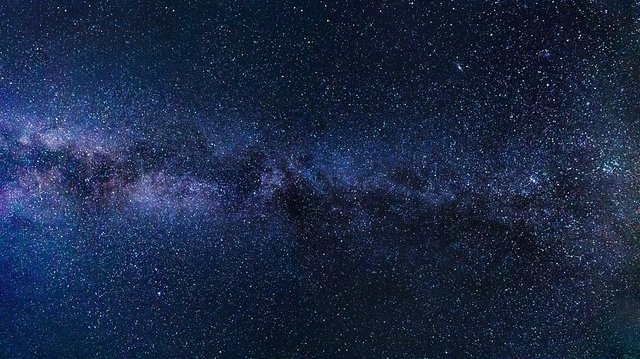
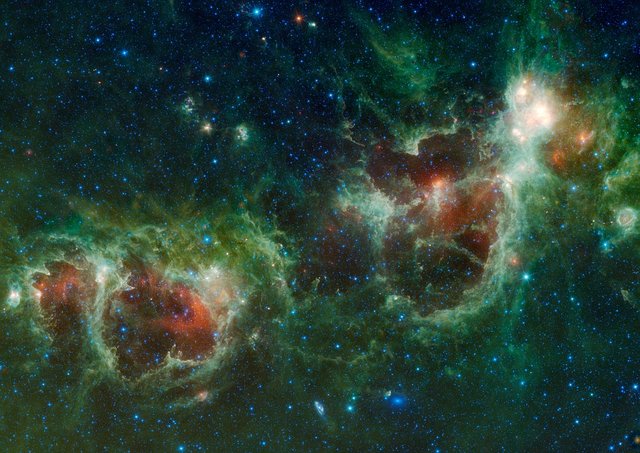

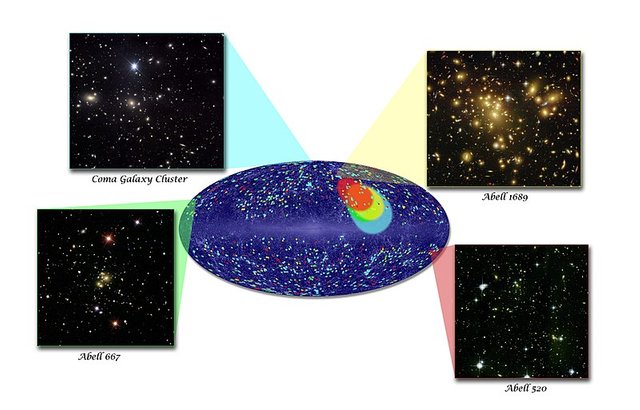
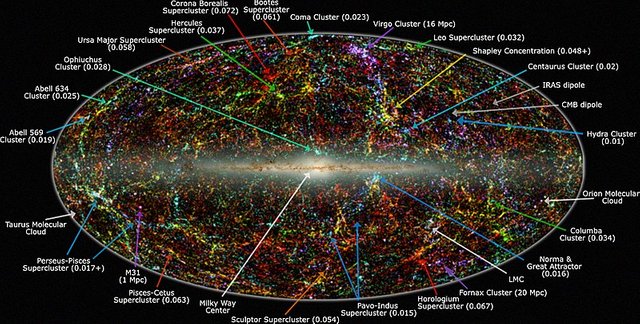
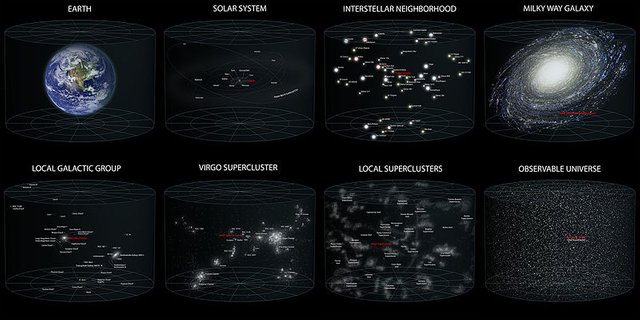
Woow, Is the twin universe for real? Or it’s just a theorized universe
Well, for now, it is still a theory, and due to the rate at which the universe is expanding due to the presence of dark energy, it might be hard to gather real evidence to prove that this twin universe is real.
Scientist and Astronomers alike will have to find an ingenious way of presenting facts if they ever hope to ever prove this theory.
Twin universe though.. Sounds interesting... When are you going to space? You seem to be interested in these a lot...
Nice work you did here fam
Probably when Elon Musk finally opens SpaceX to the public, offering cheap flights from Earth to Mars for less $10k . I'll get tickets for myself, and hopefully you as well 😂
Alakoba somebody. Be like "Taiwo" go check how it is there, I'll act as the "Kenny" afterwards...
Cheap indeed
Lols
Hi @agbona!
Your post was upvoted by utopian.io in cooperation with steemstem - supporting knowledge, innovation and technological advancement on the Steem Blockchain.
Contribute to Open Source with utopian.io
Learn how to contribute on our website and join the new open source economy.
Want to chat? Join the Utopian Community on Discord https://discord.gg/h52nFrV